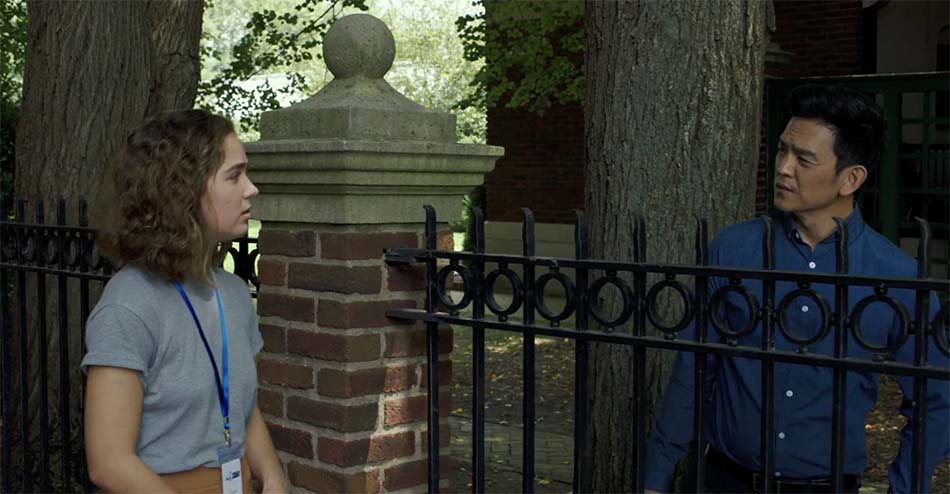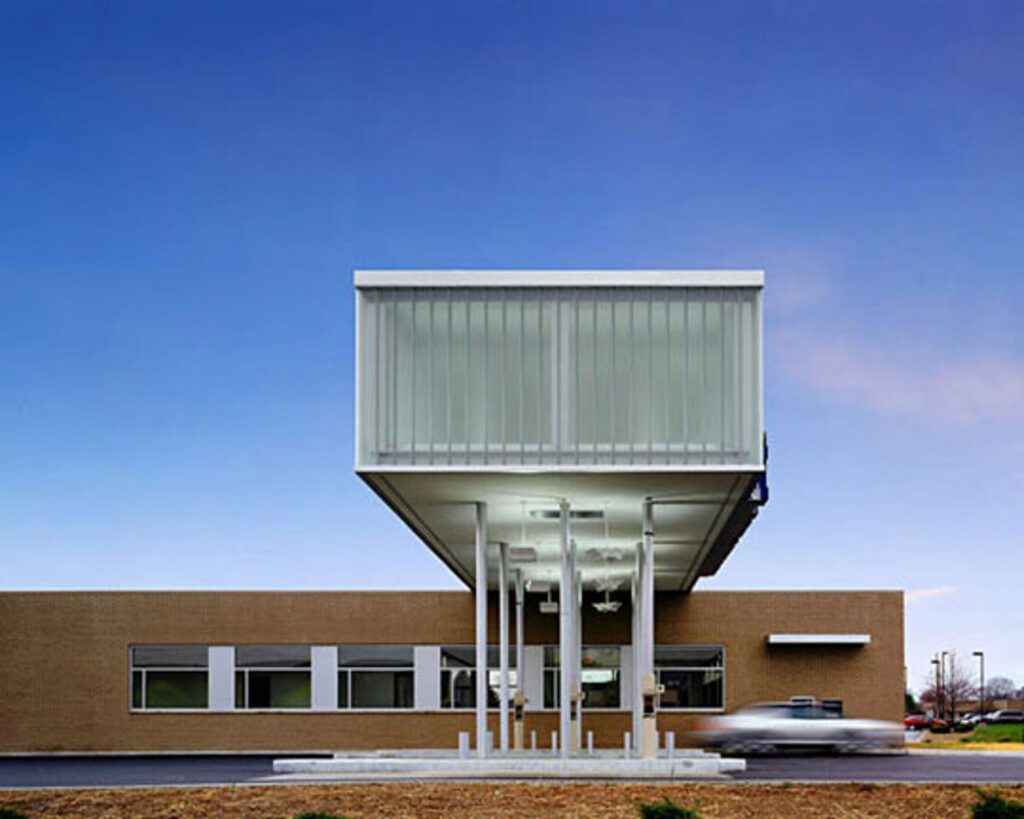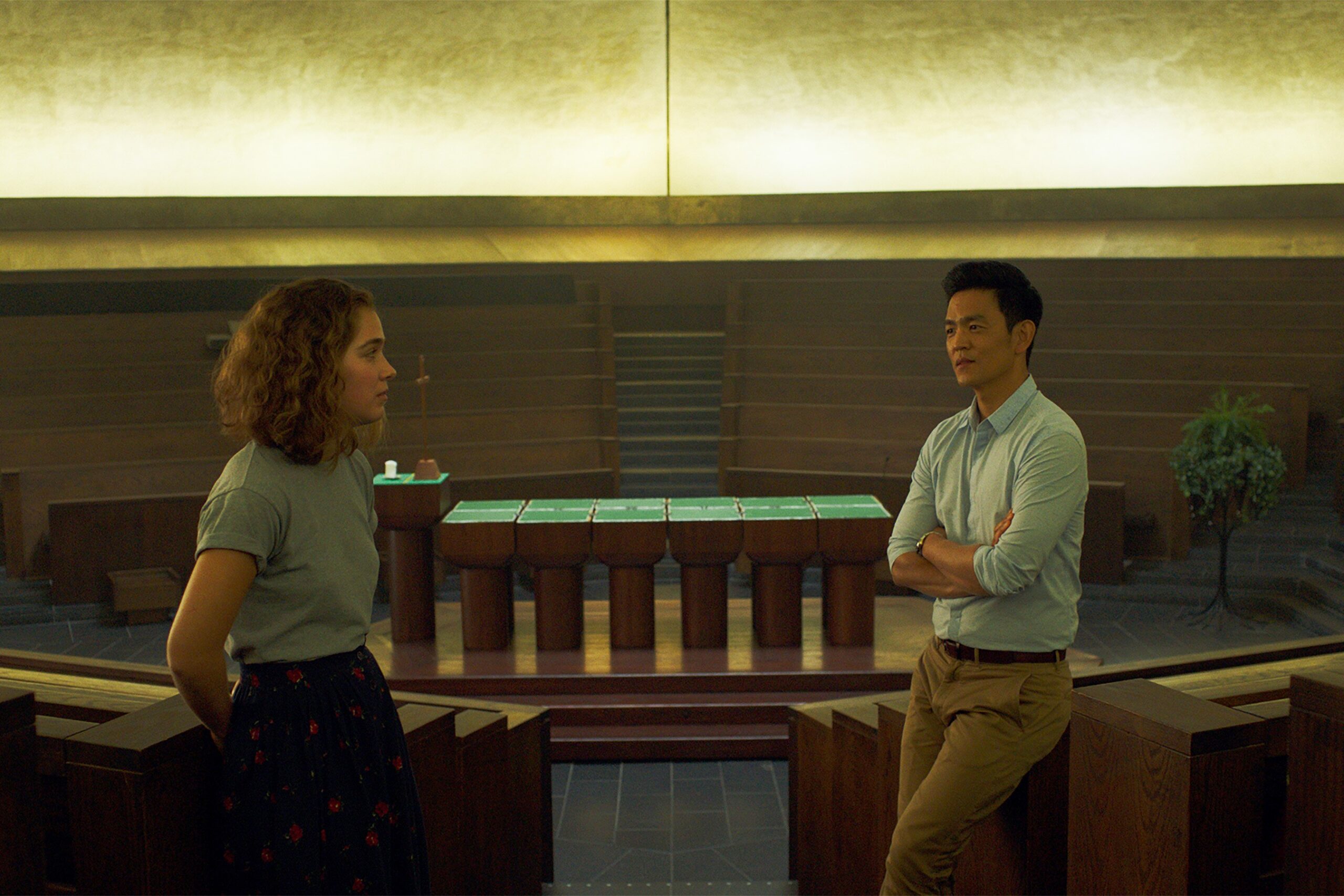OK, just stop. Look at me. Pardon me while put my hands on your face and force you to stop for a second and look into my eyes. Stopped? Good. “Watch Columbus now.”
What is it though? Sure, THiNC. has a great movie recommendation track record with you – because, of course, it does. But, I get it, you’d kind of like to know what you are walking into. Let’s see if I can triangulate it for you and explain what you are walking into. It’s as if you took the impassioned love child of Frank Lloyd Wright and Before Sunrise, you would come away with the film Columbus. You know, FLW, the architect? And Before Sunrise the Richard Linklater movie with Ethan Hawke and Julie Delpy? Blender their DNA together and you’ve got Columbus. I know?!? Perfect right. Correct. The movie is perfect. I rarely, rarely, rarely, give out perfect movie ratings, but this movie just got a 5.0, perfect rating, and it’s because it literally is perfect. “But it’s just two people walking around talking.” I know! Right!? So perfect. Alright look, I’m going to place a movie trailer right here, to block most visitors from accidentally reading my movie walkthrough. But if anyone clicks play on this thing, I’m going to come find you. Just don’t even watch any trailers for this thing. Just go watch it.
Basically, Columbus is a film that is scripted, directed, and edited by Kogonada, a genius film maker. It tells the story of Jin, the son of a renowned architecture scholar, who is forced to come to Columbus, Indiana, when his father has a medical crisis. During his stranded time in Columbus, Jin strikes up a friendship with a young architecture nerd, Casey. And over the course of the next 104 minute run time, we learn that although these two individuals are worlds apart, they still find a deeply felt connection.
Columbus Movie Walkthrough
As the movie opens we see two different threads occurring simultaneously. Eleanor (played by Parker Posey), visiting the various architectural wonders of Columbus, Indiana, with the architectural genius, Prof. Jae Yong Lee, when suddenly, he collapses. Alternatively, we watch as Casey (Haley Lu Richardson, of Split fame, and Jane the Virgin (which I haven’t seen, but is an apparent life choice failing, because every brilliant actor in the world is in that show. How?)) and Gabriel (Rory Culkin, yes, HIS younger brother) discuss the intricacies of the marginalia in some of the books at the library. (I seriously considered creating an iOS game/story out of the idea that two people could talk through time via the margins of the books at a library. You know – guy researching World War II finds details about a story of librarians slaughtered…realizes he can warn them, but then has to research more as the story changes…sort of thing. Oh, pay me no mind.) But the comments in this book talk about how society likes to say that kids today have short attention spans when they can sit and play video games for hours. When the father attempts the video game, he can’t do it for five minutes, but we don’t say that he has a short attention span, do we? The writer of the marginalia is basically offering a critique of a critique. That we don’t have a crisis of attention, but rather, we have a crisis of interest! And immediately I was wondering what Kogonada was saying here. Was he warning the viewers to watch closely? Could he be wondering aloud as to our potential lack of interest in this talking, low key affair? Will we have not a crisis of attention but rather a crisis of interest in his film Columbus? Hrmm. Are we losing interest in things that matter? There are a few other tips as to what Kogonada might be saying here in the margins of the movie… let us go then, you and I.
Jin, Professor Lee’s son, arrives in Columbus to be with his father after his falling into a coma. The two have been estranged, but duty bounds Jin to care for his father in spite of their distance. While on a phone call back to South Korea, Casey hears Jin speaking and introduces herself. (Notice how the two are talking through a fence…a barrier…and they have a rough go of it at first. “Oh, you can speak English?” “You don’t think Asians can speak English?” Yes, very bumpy.


We learn early on that Casey is a very intelligent, extremely promising, young lady. Yet, here she is, stuck in Indiana, with no plans to go off to college like all her friends, and co-workers are doing. Why? Because her mother has a history of terrible boyfriends. Oh, yeah, that and did I mention a history of meth? Yeah, she has a history of meth. Which, if we stop and think about it, basically means that Casey is wise beyond her years. She is the parent in this relationship with her mother. She is worrying about her, and constantly finding herself wrapped up in her mother’s life as she tries to keep her dry. But no child should be forced to go through that.
Quick Character Evaluation
One of the things that viewers of Columbus will find themselves doing is relating in portions to one of the two main characters. They are extremes of two types of people, individuals that hew closely to family, or distance themselves from family. Casey is an EXTREME example of a family-hewer. Jin is an EXTREME example of a non-family-hewer.
Casey <————— | —————> Jin
Jin, having been damaged by his father, found himself walking away from him. Professor Lee spent more time with his research, his work, and his lecturing, than with his family. We know from the dialog that Lee rarely took time out for his son, and that cause Jin to go his own way and to avoid his father like the plague. Casey, having been damaged by her mother’s dalliances, she found herself working extra hard to protect her mother from herself. In an attempt to hold things together, Casey worked hard to keep her mother close, and not allow horrible men near her. Men that would distract her from the goal of staying clean, and would unravel the delicate work they had accomplished together. These two people are polar opposites of the same exact psychic damage. Sure, different root causes, but they are both desperate for their parents love, attention, and appreciation. But we all are, aren’t we? When it comes right down to it? It’s funny just how badly we want to be found to be clever, smart, or appreciated by the people that brought us into the planet. Why is that? It’s really weird when you stop and think about it. And yet, we could all do with some appreciation from anyone really.
Which is why, the conversation is so interesting between these two. They both obviously appreciate the other. They find each other clever, intelligent, and really interesting. Their conversation is about as real as it gets. They are able to call each other out on their lies, and insincerities. They are able to encourage each other when the words of encouragement from others just doesn’t bear the same weight. The magic of pure conversation between two people is that both are not only listening, but they are both hearing. There is an enormous difference. Yes, I can be paying attention to someone, and not actually hear anything that they are saying. But that never happens with Casey and Jin. Their hearing receptors are dialed all the way up to eleven. And all of this hearing and talking is happening while Casey takes Jin around to her list of the top 20 architectural hot spots of the town.
The Plot of Columbus Continued
Jin’s story is sort of an impalement. A complete and utter cessation. Jin had deadlines, and a life in Korea. His work expected him to meet his translation deadlines, and for him to do what was necessary to make it all happen…oh, and grieve his dad, or whatever. But he was expected to get the job done. And yet, here he is, having this existential non-mid-life crisis as he tries to figure out what to do about his dad’s health issues that he really doesn’t care about.
Then there is Eleanor. She was there with Prof. Jae Yong Lee when he collapsed. She’s obviously a significant student of his, maybe even a key mentored apprentice of some sort? She is there with him for his lecture and talk that he is going to give. But we learn, as the movie moves on, that Jin admitted a number of years ago his love for Eleanor. It was years and years ago, probably when Eleanor was a student of the professor. But she turned Jin away then. And she turns him away now. What is that about? It’s an interesting detail about Jin. She knows him well enough to tell him to be there for his father. And she even feels comfortable enough to ask him how he feels about Casey. But Eleanor still shuts him down. It made me wonder if she had had, or was having, a relationship with Jin’s father, and she turned him down out of respect for his father maybe?
Then there is Casey’s thread. We watch as she tells Jin in detail about her worry for her mother. The woman that was hooked on meth, but worse was her addiction to bad men. And so we see how Casey enjoys hanging out with her mother, but more and more we notice that when Casey calls during her cleaning job, her mother stops answering. And when Casey calls one of her mother’s co-workers to ask about her mother, she always covers for her. Even though we watch one interaction and know for certain that Casey’s mother isn’t there. Why? Why isn’t Maria at her job?
Well, sad to say, it is probably because she quit the job, or was fired. Worse, she is most likely off chasing a man…again. And we watch several different times as her mother comes home late from her work. As Casey realizes what is happening, we start to get a bad feeling about it as well. We are never told outright, but it’s pretty clear that Maria is into something she doesn’t want her daughter to know about. Although Casey has promised herself that she needs to stay local in order to take care of her mother, she’s realizing more and more that her mother doesn’t have a similar sort of edict governing her own actions.
Then one day, Jin calls her out on it, and tells her that she just needs to chase the opportunities, and do something big, and bold. Why? Because Jin sees real potential in her. I don’t think he necessarily sees an architect in Casey, but he does see greatness of some sort. Real ability. Which is why, even though he struck out with Eleanor, and made a right mess of things in their relationship, he still petitioned on behalf of Casey with Eleanor to help give her a leg up. Obviously Eleanor is connected. But we also know that Casey had several conversations with Debra Berke, and that Berke was obviously impressed. If you remember correctly, Debra Berke was the one that created the bank, design that helped carry Casey through back when things were the bleakest for her and her mother. So, could it be that Eleanor reconnected Casey with Debra Berke? Or maybe got her a new opportunity? We just don’t really know…but one thing is clear, Casey can do pretty much anything.


The Architecture of Columbus Indiana
If you’ve ever wandered into Columbus Indiana, it really does just look like almost any other small town. I mean, it only houses something just over 40,000 residents after all…so there can’t be too much going on there, can there be? But what really stands out about this super small town is its glorious modern architecture. Modernist architecture is recognizable by its geometric and symmetrical designs. Modern architecture was an architectural style that focused primarily on a few new construction technologies – e.g., glass, steel, and reinforced concrete. Modernist architecture jettisoned really any type of ornamentation. It clung to the idea that form and function should be perfectly connected and imbues every tenet of modernist building ideals. It reigned from post World War II through until the 80’s. At which point it was punted by postmodern architecture. And throughout Columbus you will see these glorious buildings interspersed throughout the town. But they combine for a total of more than 60 historical public buildings, designed by a veritable who’s who of global architectural giants. I.M. Pei, Cesar Pelli, Harry Weese, Eero and Eliel Saarinen, Venturi and James Poshek, etc., etc., etc.
The town is such a vaunted example of architectural genius that it recently ranked sixth on the list of the top 10 American cities for architectural quality. Think about that for a second. Sixth. That means that this little backwater is competing with global cities like New York, Chicago, and San Francisco for this honor. Not only that, but six of the cities’ buildings have been named national historic landmarks. Which means that there are a steady stream of visitors parading through the town in walking groups as they ogle the towns’ various cross beams, faćades, and pitched roofs. (If you really aren’t one to ogle a cantilevered crossbeams, and whatnots, you definitely need to head on over to the blog, McMansion Hell, specifically to this post right here. Every single time she points out “An Art” I fall over laughing.)
What does it mean that this conversation between an almost traditional Asian acting American woman, and a traditionally American acting Asian man is happening within the backdrop of modernist architecture? I really don’t know. But I’m intrigued by the question and have spent the past three hours reading interviews with Kogonada, the actors, the crew…pretty much anything I could get my hands on. But I think that the glorious architecture is a false facade of control and aesthetic perfection in the face of really most everything falling apart behind the scenes.
Jin seems to have a perfect life. But it wobbles completely out of control right in front of him. Casey, a really promising high school graduate is passing on the rest of life’s possibilities. Both are completely arrested by life’s developments and now completely viewing life askance. Suspicious at really anything that might come their way. It’s a extraordinarily normal thing for life to hit us humans abroadships, spinning us all off center, and sending us in directions we don’t expect to go. I identify with Jin. Others identify more with Casey. But regardless of where you stand in relation to either of the characters, you’ll identify with their plight overall. We all find ourselves spinning off target regularly, flailing in the face of life’s chaos. It’s just the way it goes. And in the middle of all that adirectional compassing our only real connection is the connection with other human beings. Which is what really lit up all my circuitry. Casey and Jin anchor for one another amid all the chaos. They helped each other determine the way forward when the noise was too loud to determine for themselves.
Final Thoughts on Columbus
Movies like the Before Series movies, will always be my Achilles heel. Intelligent people, discussing the intricacies of life are going to win here at THiNC. forever. If you don’t like dialog, and you aren’t a fan of talking movies, it might be better if you just moved along and found someone else to give you movie recommendations. Why? Because it is authentic. Two people just trying to figure life out is always fascinating to me. Certified Copy is another brilliant movie in this same space that you will also really enjoy if this one worked for you.
Personally, I think movies like this are all but holy. Just transcendent slices of life that ascend beyond the chaos of life, and should just go on forever.
Edited by: CY

